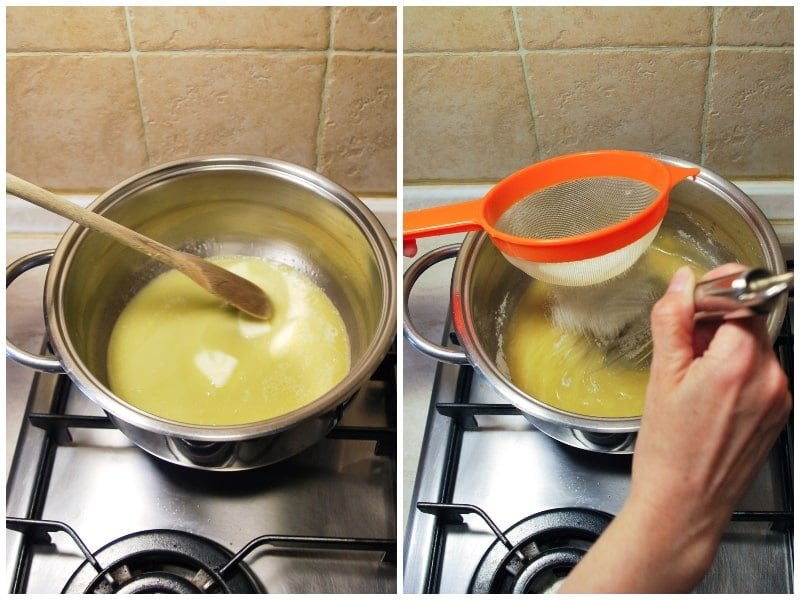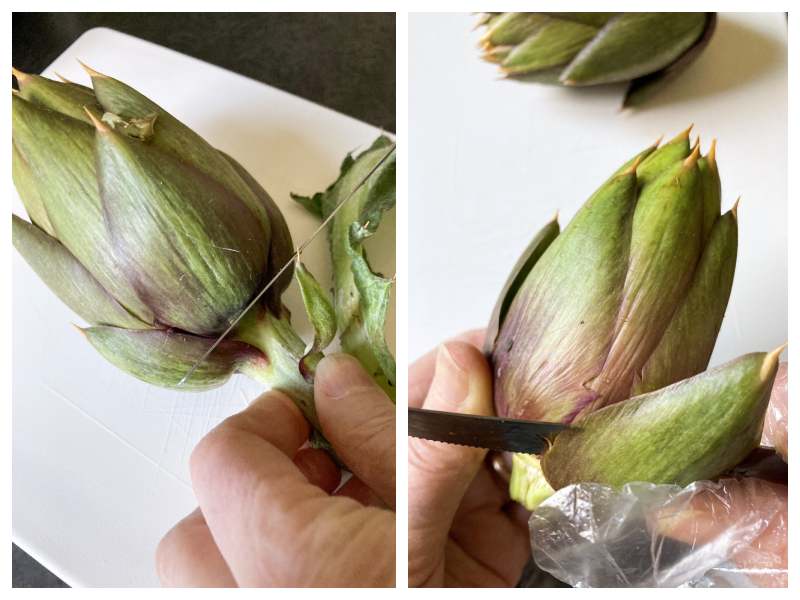Italian Artichoke Casserole Recipe is a delicious vegetarian dish that is delicious especially when you use fresh artichokes in season with an intense and unique flavor. However, if you do not have fresh artichokes, you can naturally use frozen ones as well.
Italian artichoke casserole recipe has no particular difficulty. The important thing is to clean the artichokes well and prepare a creamy velvety béchamel sauce. You can enjoy this artichoke casserole with parmigiano cheese and béchamel as an appetizer, as a vegetarian main dish or even as a side dish.

Artichokes are a great health ally. They have detoxifying and antioxidant properties and are an important source of fiber. So when their season comes, you should eat plenty of them.
Italian artichoke casserole, baked and made delicious with a crispy crust on the surface, is a perfect vegetarian dish for cooking this vegetable in a different way than usual.
Artichoke casserole is also a very practical dish. It can even be prepared a few hours in advance then eaten at the appropriate time.
Let's now see how to make Italian artichoke casserole with parmigiano and béchamel. You'll definitely have a great success with your guests!
Ingredients

Prep Time: 45 Min | Cook Time: 45 Min | Servings: 6
For the Bechamel Sauce
- 500 ml (~2 cups) of fresh whole milk
- 50 g (1.8 oz - ~½ stick) of unsalted butter
- 50 g (1.8 oz - ⅓ cup) of all-purpose flour
- ¼ teaspoon of fine salt
- freshly grated nutmeg
For the Artichoke Casserole
- 6 artichokes, medium to large size
- 150 g (1 ½ cups) of grated Parmigiano cheese
- 50 g (½ cup) of bread crumbs
- 2 eggs
- 1 teaspoon of salt
- 1 lemon
- 4 tablespoons of Extra Virgin Olive Oil
Instructions
Make the Béchamel Sauce

Step 1) - In a pan, prepare the roux by melting the butter and adding the flour. Stir with a hand whisk to remove any lumps.

Step 2) - Pour the milk into a saucepan and bring it to a boil. Then turn off the heat and pour the milk into the roux, stirring very well with a hand whisk.

Step 3) - Place back on the heat. Season lightly with salt and season with a little nutmeg. Cook, continuing to stir, until the béchamel has reached the desired consistency.
PLEASE NOTE: For more information and insights see our recipe: how to make Béchamel sauce (Besciamella)
Clean the Artichokes

Step 1) - TIP: When cleaning artichokes, they release a liquid that stains your hands. Therefore, we recommend using disposable gloves or running lemon juice over your hands to protect them.
Cut off the stems at the base of the leaves. Peel the stems and set them aside. Then remove the outermost leaves, which are the hardest. Keep only the heart of the artichoke, that is, the innermost part.

Step 2) - Cut off the tips of the artichokes, whether they are artichokes with thorns or without. Then cut the artichokes in half. Finally remove the inner part.
Leave the artichokes for about half an hour in a bowl with cold water and the juice of 1 lemon. This way the artichokes don't turn dark.

Step 1) - Cook the artichokes in boiling water for 15 minutes. Then drain very well and let them cool.

Step 2) - Transfer the boiled artichokes to a blender. Add the eggs and grated Parmigiano cheese. Blend until the mixture is as smooth as possible.

Step 3) - Transfer the mixture to a bowl and add the béchamel sauce. Stir, adjusting for salt and pepper.
The Baking

Step 4) - Pour the mixture into a baking pan greased with a drizzle of oil and sprinkled with breadcrumbs.
Sprinkle the surface also with a round of oil, a little grated Parmigiano cheese and sprinkle with breadcrumbs.

Step 5) - Place the artichoke casserole in an oven preheated to 180°C (350°F) and bake for about 45 minutes.
The surface should form a crispy, golden crust.
Remove the artichoke casserole from the oven and let it rest about 5 minutes before serving.

YOU MUST ALSO TRY:
- Italian Squash Casserole
- Roman style artichokes
- Potato Gateau | Italian mashed potato pie recipe
- Italian Green Bean Casserole | Polpettone alla Ligure
- Creamy Artichoke Pasta Recipe
- Roasted Fennel with Parmesan, Breadcrumbs and Sage
- Easy Artichoke Salad with Parmigiano Cheese
- Broccoli Casserole Recipe
Storage
You can store Italian artichoke casserole in the refrigerator for two to three days in an airtight food container. Then reheat in the oven or microwave.
You can freeze the artichoke casserole and let it thaw at room temperature.
Variations
Artichoke casserole lends itself to many variations.
- HAM: You can add for example diced cured meats, so to enrich the artichoke casserole and make it a one-pot dish. Cured meats that go best with artichokes are ham, flavorful but delicate, and speck, with its smoky flavor for an especially tasty touch.
- CHEESE: You can also enrich the flan by adding thinly sliced cheeses to the center that make it stringy. The best cheeses for this use are scamorza or provolone, even smoked if you like. Mozzarella is very suitable because of its flavor, but there is a risk that it will release too much water inside the artichoke flan. It's therefore better to choose a firm, compact mozzarella and drain any whey very well.
- SMALLER PORTIONS: You can also serve this dish in individual portions. This is a more elegant way to serve artichoke casserole, above all if you have guests for dinner or have a party with many friends.
- DECORATE: You can also decorate the small portions with artichoke wedges and a sprinkling of Parmigiano cheese.

Recipe Card

Italian Artichoke Casserole Recipe
Ingredients
For the Bechamel Sauce
- 500 ml milk ~2 cups, fresh and whole
- 50 g unsalted butter ~½ stick
- 50 g flour ⅓ cup
- ¼ teaspoon salt
- nutmeg freshly grated
For the Artichoke Casserole
- 6 artichokes medium to large size
- 150 g Parmigiano Reggiano cheese 1 ½ cups, grated
- 50 g bread crumbs ½ cup
- 2 eggs
- 1 teaspoon salt
- 1 lemon
- 4 tablespoons olive oil extra virgin
Instructions
MAKE THE BECHAMEL SAUCE
- In a pan, prepare the roux by melting the butter and adding the flour. Stir with a hand whisk to remove any lumps.
- Pour the milk into a saucepan and bring it to a boil. Then turn off the heat and pour the milk into the roux, stirring very well with a hand whisk.
- Place back on the heat. Season lightly with salt and season with a little nutmeg. Cook, continuing to stir, until the béchamel has reached the desired consistency.
CLEAN THE ARTICHOKES
- TIP: When cleaning artichokes, they release a liquid that stains your hands. Therefore, we recommend using disposable gloves or running lemon juice over your hands to protect them.
- Cut off the stems at the base of the leaves. Peel the stems and set them aside. Then remove the outermost leaves, which are the hardest. Keep only the heart of the artichoke, that is, the innermost part.
- Cut off the tips of the artichokes, whether they are artichokes with thorns or without. Then cut the artichokes in half. Finally remove the inner part.
- Leave the artichokes for about half an hour in a bowl with cold water and the juice of 1 lemon. This way the artichokes don't turn dark.
- Cook the artichokes in boiling water for 15 minutes. Then drain very well and let them cool.
- Transfer the boiled artichokes to a blender. Add the eggs and grated Parmigiano cheese. Blend until the mixture is as smooth as possible.
- Transfer the mixture to a bowl and add the béchamel sauce. Stir, adjusting for salt and pepper.
BAKE
- Pour the mixture into a baking pan greased with a drizzle of oil and sprinkled with bread crumbs.
- Sprinkle the surface also with a round of oil, a little grated Parmigiano cheese and sprinkle with breadcrumbs.
- Place the artichoke casserole in an oven preheated to 180°C (350°F) and bake for about 45 minutes. The surface should form a crispy, golden crust.
- Remove the artichoke casserole from the oven and let it rest about 5 minutes before serving.





Susan says
This Italian artichoke casserole recipe is absolutely delicious! The flavors are perfectly balanced, and the dish is both comforting and elegant. A must-try for anyone who loves classic Italian cuisine.